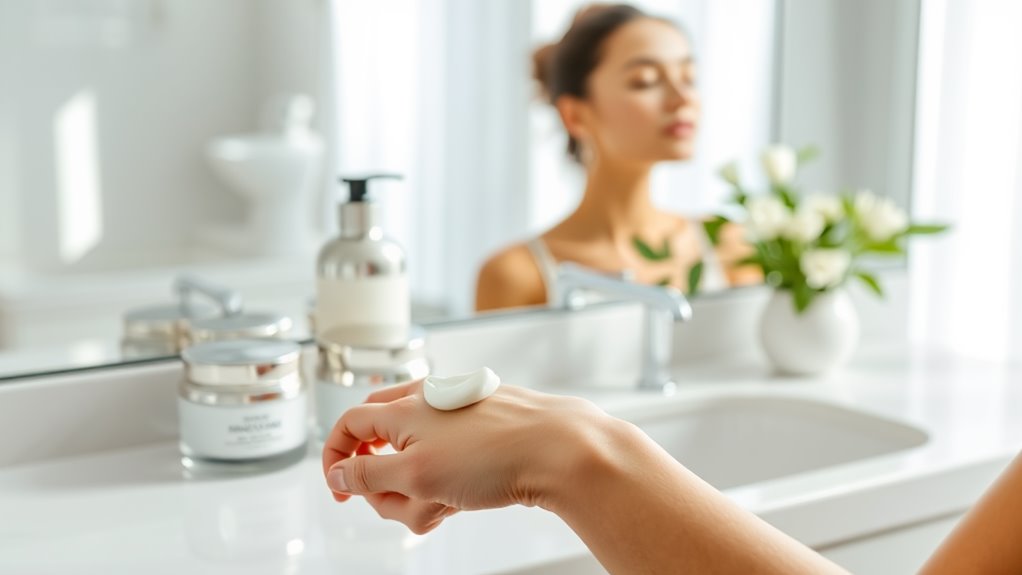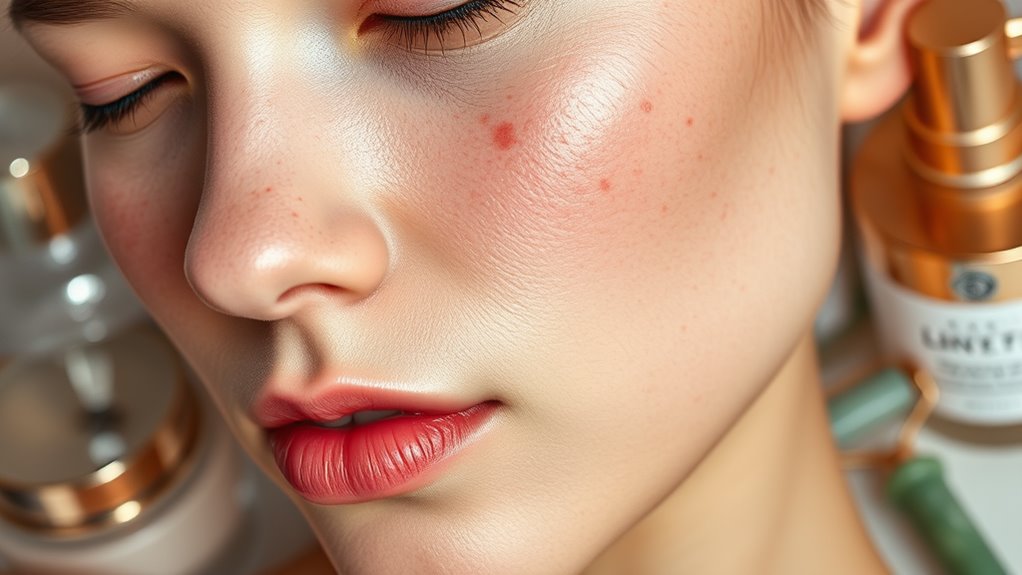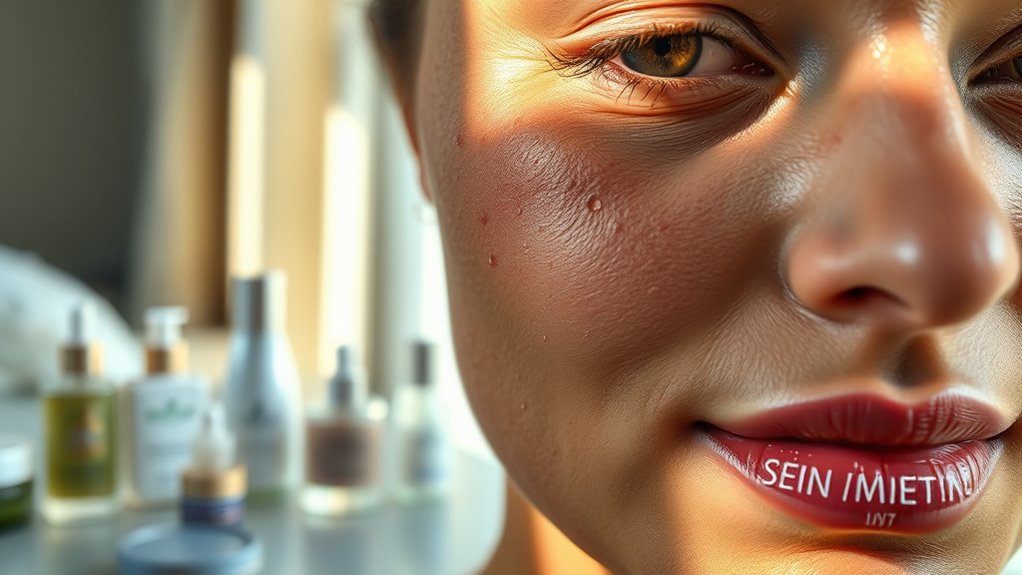You’re Moisturizing Wrong – Here’s What to Do Instead
You’re probably moisturizing wrong if you haven’t considered your skin type and timing. Identify if your skin is oily, dry, or combination and choose a suitable moisturizer formulated for your needs. Apply it after cleansing to lock in hydration and adjust your routine with the seasons. Layer humectants before occlusives for optimal hydration. Understanding these factors can drastically improve your skin’s health. Explore more tips to enhance your skincare routine effectively.
Key Takeaways
- Identify your skin type (oily, dry, combination, sensitive) to choose the most suitable moisturizer for effective hydration.
- Apply moisturizer immediately after cleansing to lock in moisture and enhance skin hydration.
- Use lightweight, non-comedogenic formulas for oily skin, and richer creams for dry skin to avoid greasiness.
- Layer humectants first to draw moisture in, followed by occlusives to seal it in for optimal hydration.
- Adjust your moisturizing routine seasonally, using heavier products in winter and lighter ones in summer for best results.
Understanding Your Skin Type
How well do you really know your skin type? Understanding your skin type is crucial to avoid common moisturizing mistakes.
Whether you have oily, dry, combination, or sensitive skin, each type requires a tailored approach. For instance, if your skin feels tight and flaky, you might be applying products meant for oily skin, exacerbating dryness. Conversely, using heavy creams on oily skin can lead to breakouts.
Conduct a simple test: wash your face and observe how it behaves over a few hours. If it gets oily quickly, you likely have oily skin; if it stays dry, you’re in the dry category. Additionally, identifying your specific skin type can help you choose the right skincare products, ensuring that you address your skin’s unique needs effectively.
The Importance of Timing
While many people focus on the products they use, the timing of your moisturizing routine is equally important for achieving optimal skin hydration. Timing ensures that your skin effectively absorbs moisture when it needs it most. Additionally, enhancing your nightly sleep routine can significantly improve skin hydration and overall appearance by promoting better sleep habits that allow your skin to repair and rejuvenate overnight.
| Time of Day | Best Practice |
|---|---|
| Morning | Apply moisturizer after cleansing to lock in hydration. |
| After Exercise | Rehydrate skin post-workout while it’s still damp. |
| Before Bed | Use a heavier moisturizer to nourish skin overnight. |
| Seasonal Changes | Adjust timing based on humidity levels for better results. |
Choosing the Right Moisturizer
Choosing the right moisturizer is essential for maintaining healthy skin, and it starts with identifying your skin type.
You’ll want to look for key ingredients that target your specific needs, such as hyaluronic acid for hydration or salicylic acid for acne-prone skin. Additionally, it’s important to remember that even oily skin needs proper hydration to prevent excess oil production. Consider the texture and absorption rate of the product to ensure it feels comfortable and effective on your skin.
Identify Your Skin Type
Understanding your skin type is crucial for selecting the right moisturizer that meets your unique needs.
Start by determining whether your skin is oily, dry, combination, or sensitive. Oily skin often produces excess sebum, requiring lightweight, non-comedogenic moisturizers. If your skin feels tight and looks flaky, you likely have dry skin, which needs richer, hydrating formulas.
Combination skin exhibits both oily and dry areas, so a balanced moisturizer that addresses both conditions is essential. Lastly, if your skin reacts easily to products, you may have sensitive skin, necessitating gentle, fragrance-free options.
By identifying your skin type, you can effectively tailor your moisturizing routine, ultimately enhancing your skin’s health and appearance.
Take the time to assess your needs for optimal results.
Key Ingredients to Look For
When selecting a moisturizer, knowing the key ingredients can make all the difference in achieving your skin goals.
Focus on these essential components to ensure your choice aligns with your skin type and concerns:
-
Hyaluronic Acid: A powerful humectant that attracts moisture, keeping your skin plump.
-
Glycerin: Another humectant that draws water into the skin, enhancing hydration.
-
Ceramides: Lipids that help restore the skin barrier, improving moisture retention.
-
Niacinamide: A form of Vitamin B3 that soothes irritation and evens skin tone.
-
Shea Butter: A rich emollient that nourishes and softens dry skin.
Texture and Absorption Rates
The texture and absorption rate of a moisturizer play crucial roles in its effectiveness and how well it suits your skin. When you evaluate a moisturizer, consider its consistency—lightweight gels absorb quickly, making them ideal for oily skin, while rich creams provide deeper hydration, perfect for dry complexions.
Pay attention to how your skin responds; a product that feels greasy may not absorb well, leading to clogged pores. Test absorption rates by applying a small amount and observing how long it takes to fully sink in.
Layering Products Effectively
To achieve maximum hydration and efficacy from your skincare routine, layering products effectively is essential.
Understanding the order of application can enhance absorption and results. Here’s how to layer like a pro:
-
Cleanser: Start with a gentle cleanser to remove impurities.
-
Toner: Use a hydrating toner to prep your skin for better absorption.
-
Serum: Apply a targeted serum packed with active ingredients based on your skin’s needs.
-
Moisturizer: Lock in hydration with a suitable moisturizer that complements your serum.
-
Sunscreen (AM only): Finish with a broad-spectrum sunscreen during the day to protect your skin.
Incorporating the right order of application can significantly boost the effectiveness of your products.
Hydration vs. Moisture: What’s the Difference?
Hydration vs. Moisture: What’s the Difference?
Understanding how to layer your skincare products effectively sets the stage for exploring the concepts of hydration and moisture.
Hydration refers to the water content in your skin, which is essential for maintaining plumpness and elasticity. You can boost hydration by using products containing humectants, which draw moisture from the environment into your skin.
On the other hand, moisture refers to the oil content that protects your skin barrier and prevents water loss. Moisturizers with occlusive agents lock in that hydration, creating a shield against environmental factors. Incorporating gentle cleansers into your routine can also help maintain your skin’s natural barrier, further enhancing its hydration and moisture levels.
Recognizing this distinction enables you to tailor your skincare routine, ensuring you’re not just superficially hydrating or moisturizing but effectively addressing your skin’s unique needs for optimal health and appearance.
Incorporating Humectants and Occlusives
To effectively moisturize your skin, it’s crucial to understand how humectants and occlusives work together.
Humectants attract moisture from the environment, helping to keep your skin hydrated, while occlusives form a barrier that locks in that moisture.
Understanding Humectants’ Benefits
While many people focus on the surface of their skin for hydration, the true secret often lies in the ingredients that draw moisture in—humectants.
These powerful compounds attract water from the environment and deeper skin layers, enhancing your skin’s hydration levels. By incorporating humectants into your routine, you can achieve a plumper, more radiant complexion.
Here are some key benefits:
- Enhanced Moisture Retention: Humectants maintain hydration levels effectively.
- Improved Skin Texture: They promote softness and smoothness.
- Reduced Appearance of Fine Lines: Well-hydrated skin appears more youthful.
- Compatibility with Various Skin Types: Suitable for oily, dry, or combination skin.
- Layering Potential: They work well with other skincare products.
Understanding humectants helps you unlock your skin’s true hydration potential.
Role of Occlusives Explained
Occlusives play a vital role in your skincare regimen by forming a protective barrier on the skin’s surface. This barrier locks in moisture, preventing water loss and enhancing hydration.
While humectants draw moisture into your skin, occlusives ensure it stays there. Common occlusive agents like petrolatum, shea butter, and beeswax create a thicker layer that’s particularly beneficial in dry climates or for dehydrated skin types.
To maximize your routine, apply humectants first, allowing them to pull moisture in, then seal it with occlusives.
This layering technique not only optimizes hydration but also fortifies your skin’s natural barrier, promoting overall health. Mastering the art of combining these two elements will elevate your skincare game significantly, ensuring your skin looks and feels its best.
Adjusting Your Routine for Seasonal Changes
As the seasons shift, your skincare routine should adapt to the changing climate to maintain optimal hydration and skin health. Here’s how to refine your approach:
-
Hydration Levels: Increase your moisturizer’s richness in winter; switch to lighter formulations in summer.
-
Exfoliation Frequency: Adjust exfoliation; more frequent in humid months, less in dry, cold weather.
-
Sunscreen: Incorporate a broad-spectrum SPF daily, even in winter, to protect against UV damage.
-
Ingredient Focus: Seek hydrating ingredients like hyaluronic acid in colder months; consider oil-based serums in dry climates.
-
Layering Techniques: Apply products in the correct order, ensuring serums penetrate before sealing with a moisturizer.




